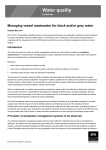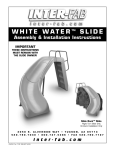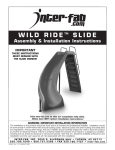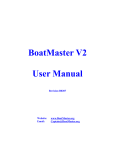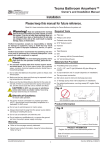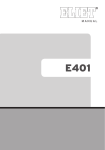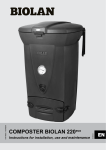Download What is vessel wastewater?
Transcript
Boat Sewage Management Information This information has been adapted with permission from the South Australian EPA 1 What is vessel wastewater? Two different types of wastewater may be created on board vessels: black water and grey water. Black water is the drainage and other wastes from any form of toilet. It also includes any other wastewater when mixed with such drainages, and includes solid human faecal wastes. Black water does not include grey water unless it is mixed with other black water wastes. Grey water is water that has been used in the galley, shower, sink and laundry. This includes water containing dissolved or undissolved by‐products such as fat and oil, food scraps, household chemicals, soap and detergent rich in phosphate, nitrate and microbiological pathogens (eg bacteria and viruses). Grey water that is mixed with black water becomes black water. There are currently no prohibitions on the discharge of grey water, but this issue may be considered in the future. What is the difference between treated and untreated wastewater? Any sewage discharged from a vessel will be either one of the following two categories: treated wastewater or untreated wastewater. Treated wastewater is wastewater that has passed through an onboard wastewater treatment system suitable for treating black water. Macerated black water is not treated black water. Untreated wastewater is all wastewater that has not passed through a treatment system, eg wastewater that is discharged directly from a toilet, kitchen or bathroom directly into a waterway (in areas where discharge is permitted) or contained in an onboard holding tank. Any untreated black water that is discharged in areas where it is permitted should first be passed through a macerator that reduces the contents to a fine slurry. What do I have to do with the wastewater and why? There is evidence that our aquatic environments are declining in water quality and whilst this is attributed to pollutants from a number of sources, including effluent discharges from sewage treatment works, industrial wastewater, farming practices and urban stormwater runoff, there are increasing calls for all contributors, including the boating community, to accept responsibility and reduce their environmental impacts for reasons of future sustainability. One small recreational vessel can cause significant harm through the release of its wastewater, especially in sensitive aquatic areas. Recent closures of shellfish farming areas due to the presence of faecal contamination– although in the Dunalley instance, not caused by sewage from boats ‐ have impacted significantly on the fishing industry itself and the wider community. FAQ: Wastewater management requirements for vessels on marine waters ‐ EPA 910/10: Managing vessel wastewater for black &/or greywater – EPA 709/10: 1 1 There are a range of options for managing wastewater that are designed to protect both humans and the environment from harm. The types of options available depend on the size of the vessel and manner in which it is used. Management options include the use of: onshore facilities (such as public toilets, bathrooms and laundry facilities) an onboard portable toilet for later disposal ashore or in open waters where discharge is permitted an onboard wastewater holding tank for later disposal ashore where pump‐out facilities are provided, or in open waters where discharge is permitted onboard wastewater treatment systems. Vessel operators need to ensure that wastewater, in particular black water, is managed appropriately and that any discharges are made in compliance with the Directive. Boaters should consider: the waters in which their boating activities will take place the number of people that they intend having onboard their vessel the amount of time to be spent boating in the various different waters the discharge requirements of those waters (especially in zero‐discharge waters). In many cases, where owners and operators of recreational boats only use their craft for day trips, compliance can be relatively straightforward and inexpensive. For example, it can be as simple as the use of a portable toilet in zero discharge waters, or fitting a macerator to the existing fixed toilet for use in open waters where discharge is permitted. While the use of onshore toilet facilities may be a good short‐term black water management solution, a more permanent and long‐term user‐friendly option should be considered, especially if your vessel makes extended or overnight trips. Regardless of vessel type or area of operation, all vessel owners and operators should ensure that toileting arrangements on vessels are installed or modified by suitably qualified personnel and conform to the minimum requirements outlined in Australian Standard AS3542–1996, Pleasure boats – toilet waste collection, holding and transfer systems, which is available from Standards Australia. What should I do when considering treatment options? Any onboard wastewater management system will only remain effective if operated and serviced to manufacturer’s standards. All systems have the potential to pose health risks, present operational problems and cause environmental impacts—although improperly designed and fitted systems carry far greater risks and should be avoided as a matter of course. Vessel operators should, where possible observe the following practices: use land‐based amenity facilities to go to the toilet, shower, wash dishes and clothing install low‐flush toilets. There are systems that use as little as 0.4 litres per flush. Provided the onboard toilets incorporate macerating devices, operators need not be concerned with solids blocking pipe systems through the use of low‐flush systems 2 install onboard wastewater treatment systems that surpass the discharge standards outlined in the Directive to reduce even further the impacts on the aquatic environment install water‐saving devices such as low‐flow shower heads and tap aerators scrape all food stuff into a garbage or compost container for land‐based disposal before immersing dishes in water cooking oils, greases and dairy products such as milk and cream decrease the performance of an onboard wastewater treatment system. Vessel operators should make every effort to prevent these products going down the sink and into an onboard treatment system use low nitrogen and no phosphorus detergents use all soaps and cleaners sparingly retain vessel‐user instruction information on board the vessel. This can include signage (stickers or labels) placed strategically around the vessel to advise on practices for operating holding tank and/or treatment systems and whilst cooking, cleaning utensils, washing clothes, showering and swimming adjacent to the vessel The following information is for guidance only. The information should be used to assist both vessel owner/operators and manufacturers of vessel wastewater management systems in purchasing and producing systems that meet acceptable standards of design and operation. Choosing a system that works best for you and your vessel depends on several factors. The answer to a few questions about how the vessel is used should help you narrow the choices and determine the most cost‐effective and practical management system: How many people are usually on board for a trip? Is the vessel used mostly for day trips or for overnight stays? Sometimes day trips will not result in the generation of wastewater. Overnight virtually guarantees it. Will the vessel be occupied and moored within a marina or operate within other sensitive areas, such as bays, estuaries or alongside aquaculture leases? The release of black water into marinas is not permitted, even if it is treated. Wastewater will need to be contained for appropriate disposal either into acceptable discharge areas (of certain marine waters) or, ideally, into land‐based wastewater collection facilities. Of course vessel operators are encouraged to utilise the marina’s toilet and amenity facilities. Consider your travel destinations. Are wastewater collection facilities available and what onboard systems/wastewaters can they service? What are the vessel’s design and space limitations? There are increasing numbers of options for vessels with minimal hull space for the fitting of wastewater holding devices, namely, flexible bladders and portable toilet designs. Is the power supply adequate for an electrically operated system, particularly systems that disinfect by seawater electrolysis? Most importantly ‐ Are you committed to the vessel wastewater management system’s service and maintenance requirements? Both wastewater holding devices and treatment systems require ongoing servicing and regular maintenance, from flushing to replacement of componentry (eg seals, couplings, filters, anodes). Ensure you discuss and understand these requirements with manufacturers/retailers before purchase. 3 What systems are available? 1: Holding devices: (portable toilets, vacuum toilets, flexible bladders and fixed tanks) 1.1 Portable toilets A portable toilet may be the simplest, least expensive way to comply with the intent of the law. They require minimal space, are low cost, simple and reliable to operate, and provide for a variety of disposal/discharge options. Their disadvantage is that they have limited capacity and require chemical dosing and frequent emptying to prevent build‐up of hydrogen sulfide. Chemicals used to dose portable toilets must be suitable for use in a septic tank. Many chemical disinfectants, deodorants, and antiseptic or germicidal powders and fluids can adversely affect the operation of septic tanks, to which vessel wastewater collection facilities may be connected. Formaldehyde is no longer an acceptable chemical for portable toilets or other holding devices. It is now understood to be an unnecessary hazard to both humans and the environment. Human exposure to formaldehyde irritates the eyes, nose and throat, and can cause skin and lung allergies. Contact can cause severe eye and skin burns. These may appear hours after exposure, even if no pain is felt. Formaldehyde can cause an asthma‐like allergy and is classified as a ‘probable human carcinogen’ by Worksafe Australia. Formaldehyde has high chronic toxicity to aquatic life. Birds and terrestrial animals exposed to formaldehyde may develop cancer or other chronic effects. Formaldehyde can persist in water between 2−20 days. Formaldehyde‐based products control odour by killing both aerobic (none odorous) and anaerobic bacteria; thus when the effluent is disposed of to sewage treatment facilities, particularly septic tanks, the process of treating the sewage aerobically can be adversely affected. Look for formaldehyde‐free chemical treatments that meet the Australian Standard AS1792 Biodegradability. 1.2 Vacuum toilets There are lightweight vacuum toilets with remote removable cassettes, which can be installed anywhere that is suitable on your vessel. When the toilet is flushed the vacuum in the system is released. The bowl is instantly cleared and the waste is moved through the piping to the remote cassette. The powerful vacuum flushing action also enables very low energy and water consumption of approximately 4−6 amps and 0.4 litres per flush. The cassette can be installed at a distance away from the toilet; thus configurations can be tailored to suit individual vessel requirements. The strong, high velocity vacuum‐flushing action breaks down the waste enroute to the remote cassette; therefore no chemicals are required to break down the waste and reduce odours. Cassettes come in various sizes to suit the number of persons on board your vessel and spares can be stored on board if required. Cassettes also provide for a variety of disposal/discharge options. Vacuum toilets cost more than portable toilets and basic holding tank configurations to install, but their ongoing maintenance requirements should be less. 1.3 Flexible bladders These come in a range of volumes to suit vessels where rigid holding tanks will not fit into the space available. They are susceptible to leakage due to chafing and flexing at pipe connections. They are low cost, provide for a variety of disposal/discharge options and may suit vessels that have few passengers and require infrequent wastewater containment only. 4 1.4 Fixed fitted toilets and tanks It is recommended that vessel operators ensure their onboard wastewater management system complies with Australian Standard AS3542 Pleasure Boats−Toilet Waste Collec on, Holding and Transfer Systems. Fixed fitted toilets should incorporate a purpose built macerating device. This is necessary for wastewater that either is to be contained on board or passed through a treatment system. Please note vacuum systems are considered to effectively macerate the waste via their operational effect. Valves (such as clack or joker valves) common to marine toilet pipework systems are not considered effective macerating devices. Aquatic discharges of untreated and treated black water into acceptable areas of the marine environment must involve the black water passing through a macerator device. The onboard macerator must effectively reduce solid wastes in the black water into a fine slurry, at least [for example, by grinding, shredding or pulping,]. The size of the holding tank selected should be based on the vessel’s intended usage and the number of people using the toilet. Suggested minimum holding tank capacities are shown in Table 1 for both conventional and marine style toilets. Table 1 Minimum toilet wastewater generation rates Holding tank pump out interval in Conventional toilet (dual‐ days flush cistern) litres/person Marine toilet (subject to model and type*) litres/person 1 32 7−15 2 64 14−30 3 96 21−45 4 128 28−60 5 160 35−75 6 192 42−90 7 224 49−105 * Vacuum toilets require 0.4 L per flush The following considerations are important when selecting a wastewater holding tank: 1.4.1 Cleaning Look for tanks that can be disassembled so that that they can be examined internally for maintenance purposes. Uric acid salts (‘crystals’ from urine and salt water flushes) and other more solid waste deposits from faeces and papers do build up over time. A round or cylindrical shape/design produces a whirlpool effect in the tank. This keeps the tank’s contents from settling and dramatically reduces the opportunity for solids to build up. Remember that any internally blocked vent should be considered dangerous, as the gas produced is explosive and poisonous. 1.4.2 Construction material A tank without welds will offer more peace of mind. Joins and welds can flex and stress with vessel movement over time, resulting in splitting, which can spill tank contents inside the vessel. 5 1.4.3 Installation Fitting a tank down inside the hull of a vessel can be difficult. A modular tank option that can be taken inside the vessel in sections and assembled to the necessary size requirement may offer a solution to otherwise expensive vessel refit/joinery alterations. 1.4.4 Ventilation Ensure the holding tank has an effective means of ventilation to the atmosphere to avoid dangerous gas build up. An insect screen should be incorporated on the vent cap. 2: Wastewater treatment systems: Black and grey water can be treated to standards that will permit vessel operators to discharge the water in acceptable discharge areas. Please refer to the Directive for treatment standards. Some treatment processes, such as composting and incineration, result in small amounts of solid waste for land‐based disposal and have no need for aquatic discharge. Wastewater treatment technologies are advancing all the time and it is likely that discharge standards will alter over time to reflect this. The following information details the type of treatment technologies that are currently available and what a manufacturer of a treatment system must demonstrate for the system to be considered acceptable for use on board a vessel. 2.1 Systems that do not require discharge to receiving waters Wastewater treatment systems that do not require discharge will not be subject to the Directive. 2.1.1 Composting toilets Composting toilets break down black water and can do so without chemicals and odour. They break down human waste and toilet paper through the natural process of decomposition. Because most of this waste is evaporated, only a very limited quantity of finished compost is produced. Oxygen, moisture, heat and organic material are needed to allow minute natural organisms to transform the waste to fertilising soil. It is recommended that this compost not be placed on garden beds where food is grown for human consumption. It is important to ensure the system evaporates residual leachate (this will usually require power to generate heat) or else this wastewater will have to be contained in a holding tank for appropriate land‐based wastewater disposal. Configuring compost toilets to fit into vessels may prove difficult and their manual maintenance requirements may dissuade some vessel operators. 2.1.2 Incinerating toilets These usually consist of a toilet connected to a holding tank and a gas‐fired or electric heating system to incinerate black water deposited in the holding tank. Recent developments have seen diesel‐fuelled systems enter the market designed to produce no ash following incineration. Previous models produced a small amount of fine, sterile ash particles that required disposal. Systems usually have a significant energy requirement, although new models can be designed to be solar and wind generated. Some of this energy can be recovered to create hot water for other uses on board the vessel. Systems can usually be integrated with existing fixed fitted toilets, require no chemicals and minimal−to−zero water usage. They are relatively odourless when compared to portable, chemically dosed toilets. Units are not entirely pollution free, with some air pollutants produced. Their installation cost entirely depends on the vessel into which they are installed and the configuration requirements. 6 2.2 Seawater electrolysis This process is a form of disinfection. It only works with seawater. The marine black water treatment system operates by electrolysis of sea water with the production of hypochlorous acid, a natural disinfectant. Many of these systems also macerate the waste into small particles. This hydrolytic system is promoted as removing or inactivating both bacteria and viruses from faecal material as it passes through the receiving tank. It is important to ensure that these systems are operated under optimal conditions. A number of variables could influence the efficiency of the operation. These include stability and voltage of electric current, salinity of water (systems are not for use in fresh water), amount of pumping required for material to flow through tanks and out to discharge, the time faecal material is left in tanks between treatments and before discharge, and the quantity of excrement treated at one time. 2.3 Physical, chemical and biological wastewater treatment The purpose of most wastewater treatment systems generally is to remove from the wastewater enough solids to permit the remainder to be discharged to a receiving water body without interfering with its ecological integrity and avoiding public health risks. Treatment must also then be provided for this removed ‘sludge’. In addition, there must be some measure of treatment to control odours, retard biological activity and destroy pathogenic organisms. As previously mentioned, systems and associated technologies are being developed and improved continuously. It is possible that these advances may in future lead to acceptable discharge, other than in accordance with the directive. The Directive may then be amended accordingly. There are numerous devices on the market currently, which combine physical, chemical and biological methods to treat black &/or grey water. They can be grouped under five methods: 2.2.1 Preliminary treatment This component is designed to remove or cut up the larger suspended and floating solids (often know as maceration), to remove the heavy inorganic solids and to remove oils and greases. 2.2.2 Primary treatment In this treatment, most of the settled out solids are separated or removed from the wastewater by the physical process of sedimentation. When certain chemicals are used with sedimentation, some of the colloidal solids (very fine particles) are also removed. 2.2.3 Secondary treatment This primarily depends on aerobic organisms that biochemically decompose the organic solids to inorganic or stable organic solids. Devices consist of activated sludge tanks and sand filters. 2.2.4 Disinfection This process is designed to kill most micro‐organisms, including pathogenic (disease‐causing) bacteria. There are several ways to disinfect, with chlorine being the most common. If the chemicals are not subsequently removed from the wastewater stream prior to discharge, they too can add to the subsequent environmental impact of the wastewater. In view of the toxicity of chlorine for fish as well as other living organisms, many manufacturers of packaged treatment systems are either incorporating chlorine removal processes prior to final discharge or using other forms of disinfection such as ozone and ultraviolet light. It is also important to note that concentrated powdered forms of chlorine can act as an oxidising agent which will intensify fires, may ignite spontaneously if damp or heated, or may explode if involved in a fire in a confined area; therefore storage on vessels is not recommended. Seawater electrolysis is a form of disinfection. 7 2.2.5 Tertiary treatment The term ‘tertiary’ treatment has developed over recent times with advancements in technology to describe additional processes that have been developed to further remove suspended solids and nutrients, primarily nitrogen and phosphorous. This degree of treatment is usually achieved by chemical (for example, coagulation) methods as well as physical methods (flocculation and activated carbon adsorption). Increasingly, membrane filtration can be used as an alternative for flocculation, sediment purification techniques, adsorption (sand filters and active carbon filters, ion exchangers), extraction and distillation. Most vessel wastewater treatment systems were manufactured to treat black water alone and primarily designed (configured) around marine travelling vessels. Increasingly, these systems are being utilised to treat grey water and are being marketed for inland travelling vessels, such as houseboats. The EPA advises vessel operators to ensure that they understand the difference between the two wastewater streams and what that means for treatment, especially in relation to which environment (marine or inland) the final wastewater will be discharged. A wastewater treatment system for grey water must, for example, be able to manage the greater flows generated from grey water sources on board and incorporate oil/grease separating devices as a minimum. Grey water can contain pathogenic (disease‐causing) bacteria, so disinfection is an essential treatment component. Vessel operators are strongly advised to consider the long‐term operation and maintenance requirements of an onboard wastewater treatment system and be prepared for a level of commitment not generally required for retaining wastewater on board for land‐based disposal. What should I look for in choosing a system? Wastewater treatment system standards Vessel operators will find numerous wastewater treatment systems available on the market and it can be a daunting exercise to assess their suitability. The EPA advises consumers to ensure manufacturers can supply onboard wastewater treatment systems that will facilitate compliance with the Directive. The following checklist should be used to assess a wastewater treatment system’s integrity. The system should include documentation from the manufacturer or supplier that states: the system’s performance specifications, under normal operating conditions, which includes a statement of the levels of water quality characteristics remaining in the wastewater after it has been treated in the system the name and address of an independent registered laboratory accredited by the National Association of Testing Authorities (visit <www.nata.asn.au> for more information) that has assessed the performance of the system against the performance specifications mentioned in the first point) the date of the assessment and the results of the assessment. The system should: include comprehensive and durable manuals for operating and maintaining the system have a durable label/identification mechanism attached to it, stating the following: 8 the manufacturer’s name and address the type and model number of the system. be installed in accordance with the manufacturer’s instructions be fitted with an indicator to indicate if the system is malfunctioning. The system service manual must state the following particulars for the system: operating instructions maintenance schedules and requirements authorised service provider 9










